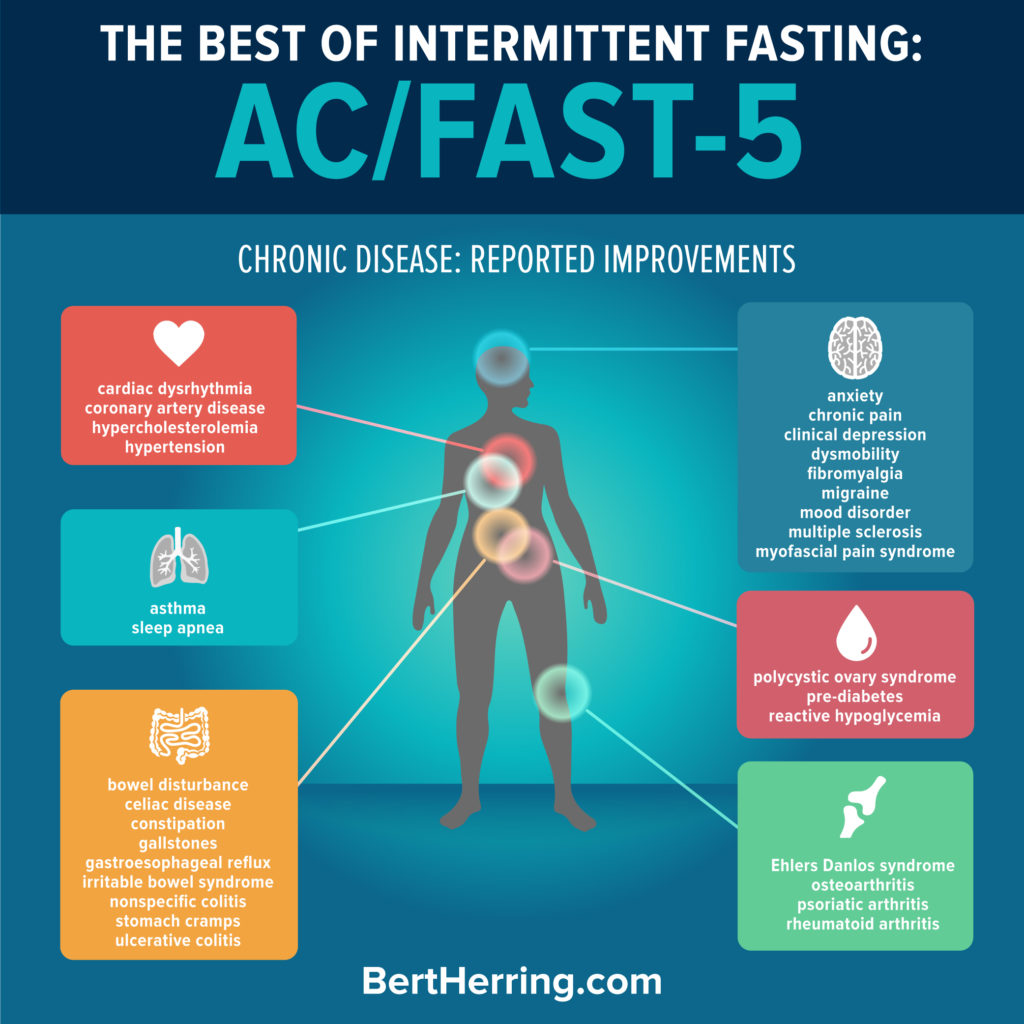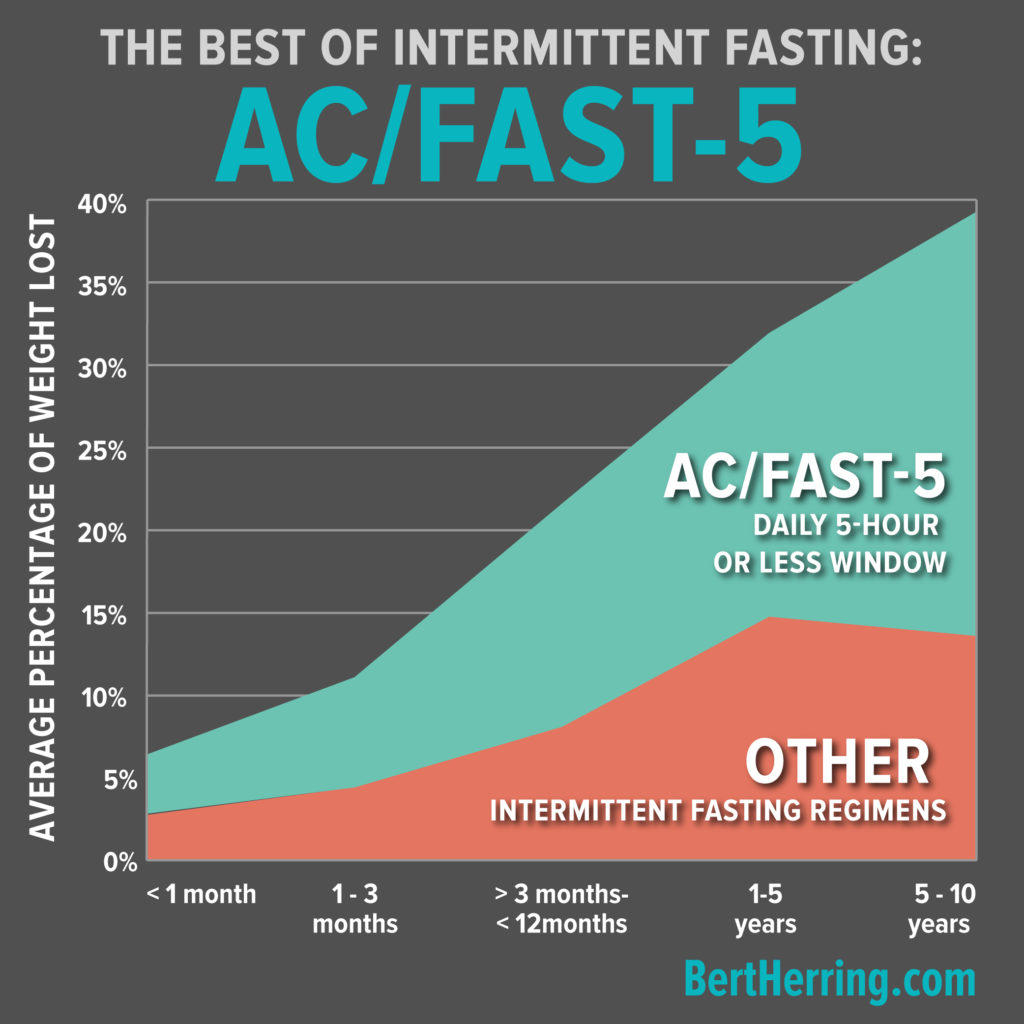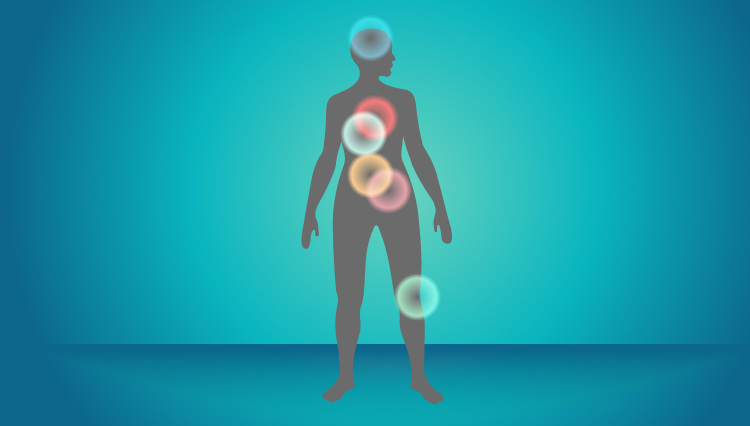I recently received email from a reader asking this question:
“Is 5 hours the best window for intermittent fasting?”
It’s no surprise people are wondering about the best window length given the sheer number and variety of intermittent fasting (IF) regimens that have been popped up since I wrote The Fast-5 Diet and the Fast-5 Lifestyle back in 2005. The question comes up often enough that it’s worth sharing answer here.
The Short Answer
The best window is the one that works best for you and to work for you, the schedule has to be effective, flexible and sustainable.
What does “working for you” mean?
A regimen that’s working for you results in three outcomes:
- You lose weight steadily.
- You don’t fight hunger.
- It naturally becomes a habit because it’s easy and simple.
You know it’s working when you achieve appetite correction.
One of the keys to having windowed eating (another name for intermittent fasting) work for weight loss is achieving appetite correction. When appetite correction happens, you don’t have to track calories or exercise willpower to eat less; you simply want less, and the weight comes off steadily with relatively little effort and little, if any, trouble with feelings of hunger.
A 5-hour window most reliably provides appetite correction.
Over 300 individuals who have followed the appetite correction (AC)/Fast-5 lifestyle described in my 2005 book, The Fast-5 Diet and the Fast-5 Lifestyle, completed a recent survey. Respondents have maintained the AC/Fast-5 lifestyle for up to ten years. Their answers to two of the survey questions (addressing window length and experience with the lifestyle) give us insight into outcomes experienced with different window lengths.
- Individuals who reported window lengths of 5 hours or less uniformly described appetite correction. They were not hungry.
- Individuals who reported window lengths longer than 5 hours most often reported fighting hunger as a barrier to sustainability.
A 5-hour window provides flexibility.
The 5-hour window is generous enough that a person can eat a meal without feeling like overstuffing is necessary, because there is time to eat later should one become hungry. The window can be moved to any time of day, and it can be moved temporarily to accommodate social occasions. The five-hour window may also be more forgiving of slips and skip days, meaning you can still see progress even if you take a day off the schedule now and then or occasionally extend the window.
Conclusion
Until a formalized study comparing various IF regimens head-to-head is conducted, the best available evidence that I know about is the 2016 AC/Fast-5 Lifestyle survey. The results of the survey reveal that the 5-hour window works best for most people. It corrects appetite so people:
- lose weight steadily
- gain freedom from hunger
- weave it naturally into their lives as an easy and simple habit
The Longer Answer
A few people achieve appetite correction with a 6- or 7-hour window. That brings up a second question.
“If the window length hits the mark of achieving steady weight loss, appetite correction and sustainability, is there any reason to shorten it to 5-hours or less?”
Of the AC/Fast-5 Lifestyle survey respondents who adhered to a 5-hour eating window and reported a history of a chronic disease, 57 percent experienced improvement in their symptoms and 24 percent decreased their medications by one or more.
The findings in the survey were no surprise in the context of anecdotal reports people living the AC/Fast-5 lifestyle have shared over the past 10 years. During that time, individuals with autoimmune or other inflammatory diseases have often told me that adopting the AC/Fast-5 lifestyle with a 5-hour eating window led to some substantial—and appreciated—anti-inflammatory effects.
The non-weight loss benefits of fasting appear to be tied to keeping insulin levels low. It makes sense that the shorter the window, the more likely one is to accrue non-weight loss benefits, but we don’t yet know the point of diminishing returns: Is a 2-hour window better than a 5-hour window?
The only logical measure we have to go on right now, until formal study is conducted comparing one regimen to another, is total low-insulin hours.
AC/Fast-5 Provides Twenty Low-Insulin “Days” Per Month
Let’s take a look at the number of low-insulin hours that the AC/Fast-5 lifestyle provides every day: 16 hours. The number of low-insulin hours is estimated assuming that an individual eats food at the start of the 5-hour window and eats food at the very end of the window. It takes about 3 hours for digestion to be completed and for insulin to return to baseline levels, leaving sixteen low-insulin hours daily. That means that during a 30-day period, the body sees a total of 480 low-insulin hours.
Let’s call 24 low-insulin hours a fasting day equivalent (FDE), so 24 low-insulin hours = 1 FDE. The AC/Fast-5 schedule of a 5-hour eating window and a 19 hour fasting period provides 20 FDEs (480 hours divided by 24 hours in a day) over the course of a 30-day month, which functionally provides 20 fasting days out of every 30.
Compare that with an 8-hour window using the same assumptions about eating times within the window. An 8-hour window provides 13 hours of low-insulin time per day, or 390 hours per 30 days. Dividing 390 hours by 24 hours in a day, an 8-hour eating window with a 16-hour fasting interval provides about 16.25 FDEs, or about 16 fasting days per month.
Biggest Loser Trainer, Bob Harper Weighs in on Intermittent Fasting
Another regimen worth addressing because of its wide media exposure in the aftermath of the Biggest Loser study featured in the NY Times is the 10-hour eating window IF regimen promoted by Bob Harper on the May 13 Today Show broadcast. The host commented on the Biggest Loser study results, which revealed that the regimen Harper had coached Biggest Loser contestants to adopt during the show actually set them back farther than if they had never lost the weight at all.
Harper responded:
“You make a really good point. Our bodies want to be the weight that we’ve been for such a long time. That’s why it’s such a battle. If you’ve been overweight for a long period of time, your body is going to fight you tooth and nail to get back. That’s why you have to be so diligent. You have to watch every single thing that you are doing, no matter if you’ve lost weight on the Biggest Loser, Weight Watchers, Jenny Craig [or] however you’ve lost the weight…You have to stay vigilant. You have to think about what you’re doing every single day. You think about when you’ve lost weight, you’ve cut out the carbs, you’ve cut out the sugar. You can never go back to that kind of lifestyle again. You have to change every single thing that you’re doing and you have to think about it every single day.”
When the host asked about IF and noted that Harper has been living an IF lifestyle for some time, Harper responded with this:
“I actually love it. I’ve been doing it for a while now. You think about people who say their metabolism has slowed down, so if its slowed down 400 calories, if you skip one meal, you could be offsetting that immediately.”
The host brought up the idea that it’s common dogma that one must eat to “keep the metabolism going.” Harper commented on the dogma:
“Right. There are studies out there. Studies are always changing, right, but like studies now are saying that like your body will start to have to work on its own fat, rely on its own fat that’s already existing on the body to start burning.”
Harper described his IF regimen:
“Right. Think about when you go to bed at night. Hopefully you’re getting eight hours of sleep, right? So count that as part of your fasting and then skip that first meal maybe and then go into you two, two and a half meals a day. That’s what I normally do…I’m not a breakfast eater any more. It’s like I haven’t been doing it. I like to eat, so it’s like if I’m going to have these two meals, I’m going to have two, big, substantial meals.”
The host mentioned that on the IF regimen described, a meal of pizza and ice cream would be appealing. Harper cautioned against that:
“Let me tell you, I would not want you to do that. Pizza and ice cream is definitely not going to help you to lose weight…I would get you to focus on eating a lot of vegetables, good fats and then get your protein. People are so obsessed of like ‘am I getting enough protein?’ If you’re having a chicken breast, you’re going to be good to go, but focus on your vegetables…You know what, starchy carbs, sugar is not a part of my diet and it shouldn’t be a part of yours.”
Harper’s 10-hour window IF regimen provides 11 hours of low-insulin time per day, or 330 hours per 30 days. Dividing 330 hours by 24 hours in a day, a 10-hour eating window with a 14-hour fasting interval provides about 13.75 FDEs, so about 14 fasting days per month.
Estimated Fasting Day Equivalents (FDE) Per Eating Window
Daily eating window (in hours) |
Daily low-insulin hours |
Monthly low-insulin hours |
Fasting day equivalents per month |
FDE per year |
| 10 | 11 | 330 | 13.75 | 165 |
| 9 | 12 | 360 | 15 | 180 |
| 8 | 13 | 390 | 16.25 | 195 |
| 7 | 14 | 420 | 17.5 | 210 |
| 6 | 15 | 450 | 18.75 | 225 |
| 5 | 16 | 480 | 20 | 240 |
| 4 | 17 | 510 | 21.25 | 255 |
| 3 | 18 | 540 | 22.5 | 270 |
| 2 | 19 | 570 | 23.75 | 285 |
| 1 | 20 | 600 | 25 | 300 |
In addition to the difference in low-insulin days per month between the Bob Harper regimen (14 low-insulin days per month) and the AC/Fast-5 regimen (20 low-insulin days per month), there’s another key difference that warrants consideration.
In his description of the 10-hour window regimen, Harper notes that one must, “change every single thing that [they’re] doing and [they] have to think about it every single day.”
How’s that working for you?
I’ve not coached people to follow the Harper regimen, but let’s look at the “working for you” list. Will the Harper regimen allow you to do the following?
- lose weight steadily
- weave it naturally into your life as an easy and simple habit
- gain freedom from hunger
Harper didn’t talk about weight loss results, so the jury’s out on that one.
His description of the lifestyle highlights a requirement for hyper-vigilance. That doesn’t sound consistent with weaving it naturally into your life as an easy and simple habit.
Regarding freedom from hunger, Harper’s characterization that maintaining weight loss means fighting your body tooth and nail doesn’t sound like freedom from hunger to me. The results from the AC/Fast-5 Lifestyle survey offer additional information to assist one in predicting whether a 10-hour eating window will allow them to achieve appetite correction. The probability is low. I mentioned these results earlier, but they bear repeating in this context:
- Individuals who reported window lengths of 5 hours or less uniformly described appetite correction. They were not hungry.
- Individuals who reported window lengths longer than 5 hours most often reported fighting hunger as a barrier to being able to sustain the eating schedule.
It was notable that in the survey responses, individuals who reported windows of 5 hours or less experienced greater weight loss than the losses seen by people with longer windows.
Regarding the Harper regimen, I have to limit my advice to this: the Study of One offers huge value in determining the regimen that works best for you. The Study of One certainly worked well for Angela, Nicole and the 300+ other AC/Fast-5 lifestyle votaries who answered the survey.
5-hour Window: Practical. Effective. Sustainable.
Does the outcome of 4 – 6 additional fasting days per month mean that the 5-hour window is better because it provides for a greater total number of hours of low-insulin time? We don’t know the answer to that yet. What we do know is that a 5-hour window as the starting point for intermittent fasting is practical, effective, and sustainable for most people who have tried it, and may deliver greater long-term fasting benefits than longer windows.





9 comments
Hi Dr Herring
I started out 4 years ago with the 5 2 diet, as in fast 2 days in the week.
Eventually I went low carb, and did intermittent fasting where I missed breakfast everyday. I would say that is a 16-18 hour fast.
I noticed my appetite has reduced dramatically. These days I just miss out lunch several times a week too, so its like several 24 hour fasts per week on top. I do this out of convenience.
If I feel hungry in the afternoon I just eat, and I fast on the days I don’t feel hungry. Its gets easier and easier.
I just read partly the e-book Fast-5, and I have a few questions. Why can’t the 5-hr window be any 5 hrs throughout the day–not just 5 pm-10 pm? For instance, if I want to go to lunch, why can’t my window be 12-5 pm? Also, I have been following dietdoctor.com, and in that they advocate a low carb high fat diet in the window, not sugary foods, or foods that turn to sugar–e.g.high carb., because of the insulin response. Also, they say that days of IF will not cause loss of muscle, which I believe I read in the Fast-5 book you say it does. Could you explain the difference in this advice?
Yes, it says in the book the window can be adjusted to fit your schedule. The 5pm-10pm window is intended as an example. Other frequently asked questions are listed here with their answers: https://www.bertherring.com/ac/fast-5/faq/
Low carb works well with Fast-5; in my more recent book (AC: The Power of Appetite Correction) I encourage minimizing (but not necessarily eliminating) sugars and foods with high glycemic indices, remembered as the “Super-BCPs” SPRBCP: Sugars, pasta, rice, bread, cereal and potatoes. The Fast-5 book says days of fasting will eventually cause loss of muscle. That means several consecutive days of not eating anything. Depending on how much fat one has stored, there’s a point where the body eventually taps muscle for fuel to avoid starvation. That’s not the same as days of intermittent fasting where one is eating one’s fill periodically, which means the body has an outside source of fuel and does not have to begin tapping into muscle to survive.
Dear Dr. Herring,
I just found your website and would like to get some more info about the 5 hour window. First of all, I don’t want to give up my morning coffee, 2 cups most days,( cream and about 1/2 tsp of sugar) and I get up around 630 am most days. I have gone till about noon to eat a meal and then just water till the next morning. My question is this….. does the coffee that I have open my window and if it does, if I can drop the cream and sugar will that still open the window? I have been only eating at noon for about 5 days now and I am not hungry most of the time (if I get hungry, it seems to go away if I distract myself). I want to read more about your ideas and look forward to learning more about your AC ideas.
thanks, D. Morgan
Coffee by itself is fine during the fasting window. Added sugar or cream contain enough calories to call it a fast-breaker. Likewise, tea is fine as long as it’s unsweetened or coated with fruit juice (if it tastes sweet, it probably has sugar in it). If you haven’t read the AC book, I believe you’ll find it worthwhile, as it incorporates Fast-5 with 10 years’ worth of experience and feedback from real-world users like you.
Thank you for helping me become at peace and free of the constant turmoil of pain and dissappointment that my weight issues caused. I have been following your plan since May 1st 2016 and have steadily lost 35 lbs without stress. I will follow this plan for the rest of my life because I feel great and free from the power that food had over me. I told my husband that I refuse to diet again unless it is something that I can do for life because diets are never is sustainable and I ended up heavier than before. This timing of eating to control insulin levels is key for me. I achieved appetite control and rarely feel really hungry even when it is time to open my eating window. I am yelling this from the rooftops to anyone that will listen. Thank you Dr. Herring.
You’re welcome, and thanks for adding your experience here and for sharing it with others!
I stopped eating during working hours about eleven months ago. I didn’t really need to loose weight, but I wanted to stay young for a bit longer. It was very easy, and I noted benefits almost at once. For the record I am a 52 year old woman with a physical job. I’m on the go all the time, stressing around like a madwoman..
I feel more focused at work, better memory, no need for breaks all the time. I actually enjoy that little pang of hunger towards the end of the day, when it’s time for me to plan my main meal.
I crave good food, even if I give in to a slice of toasted bread now and again. I have thrown away so many sweet treats. There is no room for them in my belly anymore.
My body looks and feels OK, I never try to diet – it is just so simple to do this. And it doesn’t cost anything.
People say we have caveman metabolism. Breakfast? Bread and cereal? Deadly!
Let your body use its batteries. Charging them, your cells, is important. So is using that stored energy, before you recharge. You must use those batteries, or they go dead…
In my opinion intermittent fasting on a daily basis is simple and effective to stay fairly fit with very little effort.
Great post, Dr. Herring.
I think a good follow up post to this would be one discussing the benefits/advantages of keeping insulin levels low.
Keep it up. Been following you for years and love seeing the progress the “Fast 5” brand (if it can be called that) has made over the years.